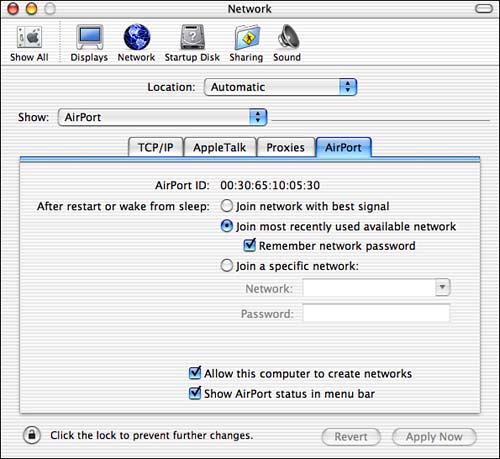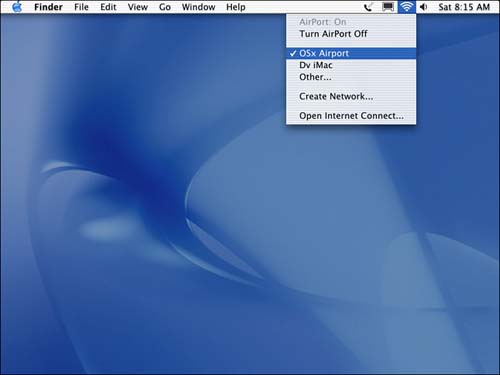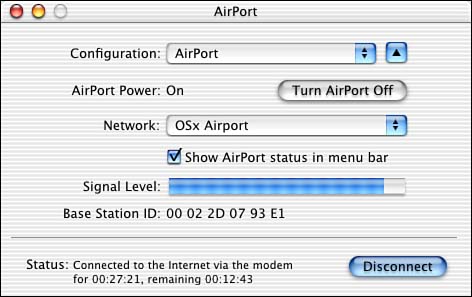| After an AirPort network has been established, you can access it from any AirPort-equipped Mac (running Mac OS 9 or Mac OS X). First, install an AirPort card in each Mac you want to add to the network. Then, configure each Mac to access the AirPort network. Installing an AirPort Card An AirPort card contains the hardware receiver, transmitter, and firmware that enables a Mac to communicate with an AirPort network (including a Base Station or other AirPort-equipped machines). Each machine that will access an AirPort network must have an AirPort card installed in it. When your Mac detects that an AirPort card is installed, it will activate the AirPort software that is part of all Mac OS installations since Mac OS 9. If you ordered an AirPort card to be installed when you ordered your Mac, you can skip this section. If you obtained the AirPort card separately, you need to install it in the AirPort card slot in your Mac. Generally, this involves exposing the AirPort card slot, inserting the card in the slot, connecting the antenna to the card, and then closing up the machine. On Power Mac G4s and Power Mac G4 Cubes, you open the case to access the AirPort card slot. On older iMacs, you open the rear panel to expose the slot (for some iMacs, the card fits into an adapter that you install into the iMac AirPort card slot). Newer iMacs have the AirPort card slot on the bottom side of the case. On PowerBooks and iBooks, the AirPort card slot is located underneath the keyboard or just above the bottom cover (on PowerBook G4s, you remove the bottom cover to access the AirPort card slot). NOTE When you order an AirPort card separate from a machine, it includes an installation pamphlet that provides installation instructions for every Mac model. The owner's manual for your Mac will also contain the instructions you need to install an AirPort card.
Because of the differences in the location of AirPort slots on various models, the exact steps to install the card are slightly different. However, in no case is installing a card particularly difficult. As an example, the following steps describe how to install the card in a Power Mac G4: -
Shut down the machine, disconnect any cables that prevent you from opening the case, and open the case. -
Locate the AirPort card slot; in Power Mac G4s, the slot is located on the same side as the motherboard near the front of the machine toward the bottom of the case (see Figure 11.11). Figure 11.11. Installing an AirPort card in a Power Mac G4 takes less than 5 minutes (and most of that time is required to disconnect and reconnect cables).
-
Insert the card into the metal guide with the bar code side of the card up; push the card until the end of the card is inserted into the connector mounted on the motherboard. -
Connect the antenna to the hole on the card (see Figure 11.12). Figure 11.12. This Power Mac G4 has an AirPort card installed and is now ready to connect via AirPort.
-
Close up the case, reconnect any cables you disconnected, and restart the machine.
Configuring Mac OS X to Join an AirPort Network To access an AirPort network, you must configure a Mac OS X machine to connect to it. You can do this in several ways. First, use the AirPort tab of the Network pane of the System Preferences utility to determine which AirPort networks your Mac uses by default when it restarts or wakes up from sleep. Configure your default, or preferred, AirPort network with the following steps: -
Open the System Preferences utility and click the Network icon to open the Network pane. Choose AirPort from the Show pop-up menu. -
Click the AirPort tab (see Figure 11.13). Figure 11.13. This Mac has been configured to use the most recently used and currently available AirPort network as its preferred (default) AirPort network.
-
To have your Mac join the AirPort network with the strongest signal, click the "Join network with best signal" radio button. This will cause your Mac to scan all the available networks and log on to the one that has the best signal. If you haven't saved the password for the network that your Mac selects, you will have to enter the password manually. -
To join the network that you used most recently and that is currently available, click the "Join most recently used available network" radio button and check the "Remember network password" check box. -
To join a specific network, check the "Join a specific network" radio button, select the network you want to join on the drop-down list, and enter the password. -
Check the "Show AirPort status in menu bar" check box to put the AirPort icon on your menu bar. You can use this icon to quickly select and control your AirPort connection. -
Click Apply Now and quit the System Preferences utility.
NOTE As your Mac connects to the network, the name of the network to which you are connecting will briefly appear next to the AirPort icon in the menu bar.
If you want to use an AirPort network other than your preferred one, select the network you want to use on the AirPort menu on the menu bar and select the AirPort network to which you want to connect (see Figure 11.14). If its password is not already stored on your keychain, you will be prompted to enter it. Do so and you will be logged on to the AirPort network. Figure 11.14. The AirPort icon on the menu bar provides control over AirPort under Mac OS X (the preferred network is marked with the check mark).
TIP When prompted to enter your password, check the "Add to Keychain" check box to have Mac OS X remember the password so that you don't have to enter it again.
 | If you can access an AirPort network, but can't access the Internet, see "I Can't Access the Internet Through AirPort Even Though I Can Connect to the AirPort Network" in the Troubleshooting section at the end of this chapter. |
You can use the AirPort menu on the menu bar to control AirPort in several ways, including the following: Measure the signal strength of the connection The "waves" emanating from the AirPort icon show the relative strength of the signal your Mac is receiving. As long as you see two or more "waves," the signal you are receiving is plenty strong. Turn AirPort on or off You can disconnect your Mac from the AirPort network by turning AirPort off. Choose a different AirPort network from the list of available networks When you do so, you will be prompted to enter the password for that network unless you have saved the password to your keychain. Do so and you will change to the network you select. NOTE Some AirPort networks are "hidden" and do not broadcast their identity. In order to join such a network, you must know the name and password of the network you want to join. To join a hidden network, choose Other on the AirPort menu on the menu bar, enter the name and password for the network, and click OK.
Create a computer-to-computer network When you choose Create Network, you can create a network between two or more AirPort-equipped Macs. In the Computer to Computer dialog box, enter the name and password of the network you are creating, choose the channel you want to use, and then click OK. Other users will be able to select the network you create on their AirPort menus to connect to the network you create (of course, you need to provide the password for your network to those users). When your Mac is hosting a computer-to-computer network, the AirPort icon changes to a Mac "inside" a quarter circle to show that you are in the computer-to-computer mode. To switch to another AirPort network, select it on the AirPort menu. The Channel you choose for a network controls the frequency of the signal that is used to create an AirPort network. If you have trouble connecting to other machines over the network you create, try a different channel. When you create and use a computer-to-computer network, other AirPort connections, such as the one you use to connect to the Internet, are deselected and so can't be used. TIP Computer-to-computer networks are a great way to play network games. You can create an AirPort network and host a game. Other users can connect to the network and join the game by selecting your network using their AirPort controls.
Open Internet Connect to control the Internet connection You can choose Open Internet Connect to open the Internet Connect application to control the connection you are using via AirPort. You can turn AirPort on or off, choose the network you want to use, see the strength of the signal your machine is receiving, and so on (see Figure 11.15). For example, if your Base Station connects to the Internet over a dial-up connection, click the Disconnect button to disconnect the Base Station from the Internet. To connect again manually, click the Connect button. Figure 11.15. You can also control an AirPort connection to the Net by using the Internet Connect application.
NOTE To use Internet Connect to control an AirPort network, choose AirPort on the Configuration pop-up menu. Internet Connect works for an AirPort connection very similarly to how it works for a dial-up connection.
 | If you are getting no signal or a weak signal from the AirPort network you want to join, see "Weak Signal" in the Troubleshooting section at the end of this chapter. |
Using AirPort is a great way to quickly create and use wireless networks. After you have connected to the Net without wires (especially when roaming with a PowerBook or iBook), you won't want to settle for anything else. Although this chapter has focused on using AirPort to access the Internet, an AirPort connection works just like any other network connection (such as an Ethernet connection). For example, you can access the files on another machine over an AirPort network just as you can with an Ethernet network. |




